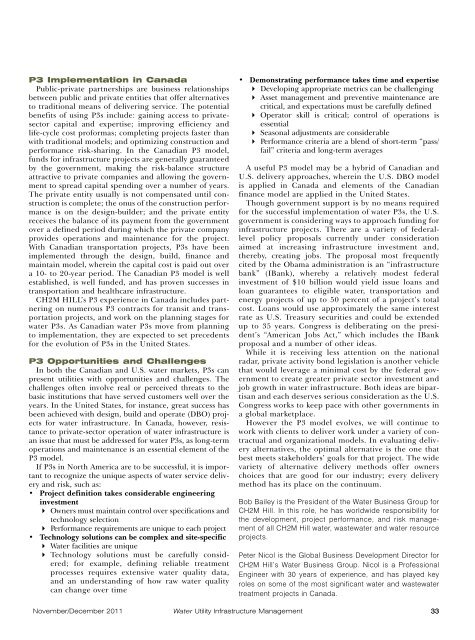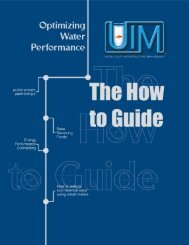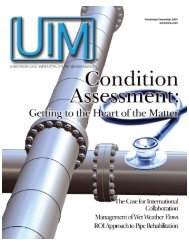Download - Water Utility Infrastructure Management
Download - Water Utility Infrastructure Management
Download - Water Utility Infrastructure Management
Create successful ePaper yourself
Turn your PDF publications into a flip-book with our unique Google optimized e-Paper software.
P3 Implementation in Canada<br />
Public-private partnerships are business relationships<br />
between public and private entities that offer alternatives<br />
to traditional means of delivering service. The potential<br />
benefits of using P3s include: gaining access to privatesector<br />
capital and expertise; improving efficiency and<br />
life-cycle cost proformas; completing projects faster than<br />
with traditional models; and optimizing construction and<br />
performance risk-sharing. In the Canadian P3 model,<br />
funds for infrastructure projects are generally guaranteed<br />
by the government, making the risk-balance structure<br />
attractive to private companies and allowing the government<br />
to spread capital spending over a number of years.<br />
The private entity usually is not compensated until construction<br />
is complete; the onus of the construction performance<br />
is on the design-builder; and the private entity<br />
receives the balance of its payment from the government<br />
over a defined period during which the private company<br />
provides operations and maintenance for the project.<br />
With Canadian transportation projects, P3s have been<br />
implemented through the design, build, finance and<br />
maintain model, wherein the capital cost is paid out over<br />
a 10- to 20-year period. The Canadian P3 model is well<br />
established, is well funded, and has proven successes in<br />
transportation and healthcare infrastructure.<br />
CH2M HILL’s P3 experience in Canada includes partnering<br />
on numerous P3 contracts for transit and transportation<br />
projects, and work on the planning stages for<br />
water P3s. As Canadian water P3s move from planning<br />
to implementation, they are expected to set precedents<br />
for the evolution of P3s in the United States.<br />
P3 Opportunities and Challenges<br />
In both the Canadian and U.S. water markets, P3s can<br />
present utilities with opportunities and challenges. The<br />
challenges often involve real or perceived threats to the<br />
basic institutions that have served customers well over the<br />
years. In the United States, for instance, great success has<br />
been achieved with design, build and operate (DBO) projects<br />
for water infrastructure. In Canada, however, resistance<br />
to private-sector operation of water infrastructure is<br />
an issue that must be addressed for water P3s, as long-term<br />
operations and maintenance is an essential element of the<br />
P3 model.<br />
If P3s in North America are to be successful, it is important<br />
to recognize the unique aspects of water service delivery<br />
and risk, such as:<br />
• Project definition takes considerable engineering<br />
investment<br />
<br />
Owners must maintain control over specifications and<br />
technology selection<br />
<br />
Performance requirements are unique to each project<br />
• Technology solutions can be complex and site-specific<br />
<br />
<strong>Water</strong> facilities are unique<br />
Technology solutions must be carefully considered;<br />
for example, defining reliable treatment<br />
processes requires extensive water quality data,<br />
and an understanding of how raw water quality<br />
can change over time<br />
• Demonstrating performance takes time and expertise<br />
<br />
Developing appropriate metrics can be challenging<br />
<br />
Asset management and preventive maintenance are<br />
critical, and expectations must be carefully defined<br />
<br />
Operator skill is critical; control of operations is<br />
essential<br />
<br />
Seasonal adjustments are considerable<br />
<br />
Performance criteria are a blend of short-term “pass/<br />
fail” criteria and long-term averages<br />
A useful P3 model may be a hybrid of Canadian and<br />
U.S. delivery approaches, wherein the U.S. DBO model<br />
is applied in Canada and elements of the Canadian<br />
finance model are applied in the United States.<br />
Though government support is by no means required<br />
for the successful implementation of water P3s, the U.S.<br />
government is considering ways to approach funding for<br />
infrastructure projects. There are a variety of federallevel<br />
policy proposals currently under consideration<br />
aimed at increasing infrastructure investment and,<br />
thereby, creating jobs. The proposal most frequently<br />
cited by the Obama administration is an “infrastructure<br />
bank” (IBank), whereby a relatively modest federal<br />
investment of $10 billion would yield issue loans and<br />
loan guarantees to eligible water, transportation and<br />
energy projects of up to 50 percent of a project’s total<br />
cost. Loans would use approximately the same interest<br />
rate as U.S. Treasury securities and could be extended<br />
up to 35 years. Congress is deliberating on the president’s<br />
“American Jobs Act,” which includes the IBank<br />
proposal and a number of other ideas.<br />
While it is receiving less attention on the national<br />
radar, private activity bond legislation is another vehicle<br />
that would leverage a minimal cost by the federal government<br />
to create greater private sector investment and<br />
job growth in water infrastructure. Both ideas are bipartisan<br />
and each deserves serious consideration as the U.S.<br />
Congress works to keep pace with other governments in<br />
a global marketplace.<br />
However the P3 model evolves, we will continue to<br />
work with clients to deliver work under a variety of contractual<br />
and organizational models. In evaluating delivery<br />
alternatives, the optimal alternative is the one that<br />
best meets stakeholders’ goals for that project. The wide<br />
variety of alternative delivery methods offer owners<br />
choices that are good for our industry; every delivery<br />
method has its place on the continuum.<br />
Bob Bailey is the President of the <strong>Water</strong> Business Group for<br />
CH2M Hill. In this role, he has worldwide responsibility for<br />
the development, project performance, and risk management<br />
of all CH2M Hill water, wastewater and water resource<br />
projects.<br />
Peter Nicol is the Global Business Development Director for<br />
CH2M Hill’s <strong>Water</strong> Business Group. Nicol is a Professional<br />
Engineer with 30 years of experience, and has played key<br />
roles on some of the most significant water and wastewater<br />
treatment projects in Canada.<br />
November/December 2011 <strong>Water</strong> <strong>Utility</strong> <strong>Infrastructure</strong> <strong>Management</strong> 33








